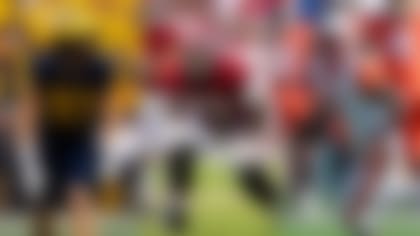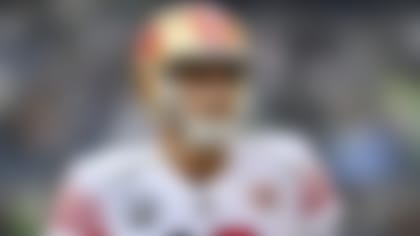Stumbling in the NFL Scouting Combine doesn't automatically spell doom for a prospect's career.
Some of the players who posted disappointing workouts will fail to make their mark in the NFL, but some will go on to be successful pros. The trick is figuring out who fits in which category.
Here are eight youngsters (listed in alphabetical order) who I still like to have an impact at the next level despite subpar combine showings:
Last week, I listed Armstead, who remained something of an unknown after three years at Oregon, as one of the prospects with something to prove heading into the combine. As it turned out, he didn't exactly prove anything. Armstead's numbers ended up being merely OK: He posted a 5.10-second 40-yard dash, 24 bench reps, a 34-inch vertical jump, a 9-foot-9 broad jump and a 4.53-second short shuttle. He also failed to show a great first step, though he had slightly above-average athletic ability. Still, Armstead has "potential" written all over him. What keeps me from being discouraged? His impressive performance in the College Football Playoff Championship Game, during which he racked up nine total tackles and a fumble recovery. His less-than-stellar combine showing aside, I still think Armstead has a chance to be something in pro football.
Dawson clearly got it done in pads during his time at TCU, compiling 136 total tackles, six sacks and four interceptions en route to being named the Big 12 Defensive Player of the Year in 2014. His performance in Indy, which included a poor showing in the 40-yard dash (4.93 seconds), did not match that level of production. He also didn't look very smooth dropping back into coverage. Still, he was such a competitive overachiever as a Horned Frog that I'm confident he can overcome his lack of speed and athletic ability to be effective at the next level. In fact, he reminds me of linebacker Brandon Spikes, who produced at Florida, struggled in the pre-draft period, then proved to be a solid pro, first with the Patriots and now with the Bills.
Hackett had seven picks and was named All-Big 12 last season. He was very effective against the run (13 tackles vs. Oklahoma) and is a good tackler. But he posted the worst 40 time in his position group (4.81) and had one of the worst vertical jumps (32 inches). I also did not see the range on pass coverage that he showed at TCU. Hackett is much more impressive with full gear on than when he's running around in T-shirt and shorts. As with Dawson, I like Hackett to overcome his lack of raw speed with his competitiveness.
Havenstein recorded pedestrian numbers at the combine (including 16 reps in the bench press, a 5.46 40, a 28.5-inch vertical jump, an 8-foot broad jump and a 4.87-second short shuttle). He did not appear to move well and didn't look very fast or strong. But he was on a Wisconsin team that won a lot of games (39) and featured a great running attack during his time there. The Badgers rushed for 200-plus yards 12 times and 300-plus yards five times last season, and Havenstein did not get called for holding once in 2014 while surrendering just 2.5 sacks. He's been extremely well coached and demonstrates great technique. Will that help him against NFL-level pass rushers? Only time will tell, but I have faith.
Jackson's arms measured 32 5/8 inches long, which is about an inch shorter than would be ideal. He also posted one of the slower 40 times (5.52 seconds) recorded in Indy this year, and did not lift, which is a concern. But the bottom line is, Jackson was a three-year starter for a Florida State squad that won the 2014 BCS Championship and was a national title contender throughout his time there, and he surely benefitted from the instruction of outstanding line coach Rick Trickett. In 2014, Jackson was not called for holding once and yielded just 1.5 sacks. When you start and play well for a team like the Seminoles, there must be something there.
Matias had the same lackluster 40 time as Jackson and posted worse numbers than his former Seminoles teammate in the vertical jump (17.5 inches to Jackson's 25 inches) and broad jump (7 feet to Jackson's 8 feet). He didn't look very athletic or quick, either. But, of course, like Jackson, Matias was a three-year starter on a very successful team. He also simply did not give up sacks.
Peters had his issues at Washington, ultimately being dismissed in early November after reportedly arguing with an assistant coach during practice. But he also has promise; one scout told me last fall that Peters was one of the best corner prospects on the West Coast in the past 10 years. At the combine, his height (5-11 5/8) and weight (197 pounds) looked good, but his workout was just OK, marked by a so-so 4.53 40. He didn't appear to be very quick and displayed questionable ball skills. The performance might seem a bit puzzling; after all, he did have a plethora of pass breakups in the first eight games of the season. I suspect his showing had something to do with the fact that he hasn't played in a game since Nov. 1. I'm sure he's been training since then, but there's a difference between being in training shape and being in football shape. Peters can be very good in the NFL, provided he comes to realize he should be working for his team, and that the team doesn't work for him.
Yeldon didn't jump out at you or look special in the drills. He didn't appear to have very good change-of-direction ability while running. And I know Alabama backs of late have missed (Mark Ingram, Trent Richardson) in their first few pro seasons more than they've hit (Eddie Lacy). But I still like Yeldon, who racked up 3,322 yards and averaged 5.8 yards per carry in three years at Alabama, to be a pretty good NFL player. I especially like that he had a history of making big plays when the Crimson Tide really needed it; he was a lock to convert on third down. He catches the ball well enough (46 receptions for 494 yards and two scores) that he can be in on all three downs, no matter what the situation is.
Follow Gil Brandt on Twitter _@GilBrandt_.













